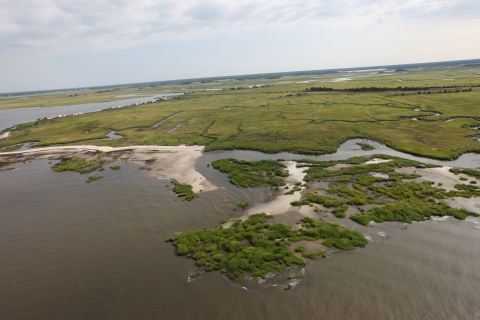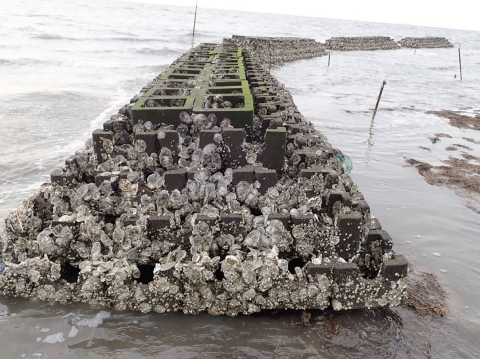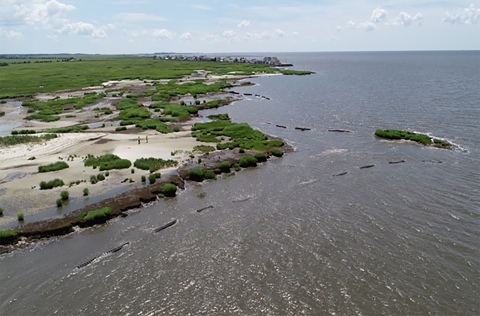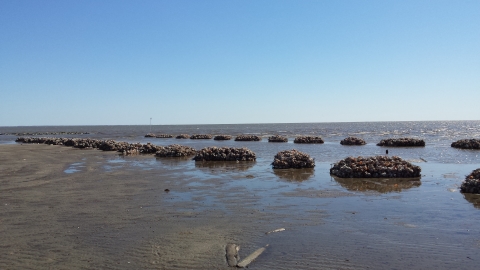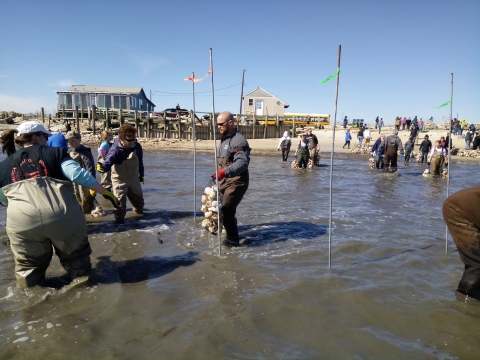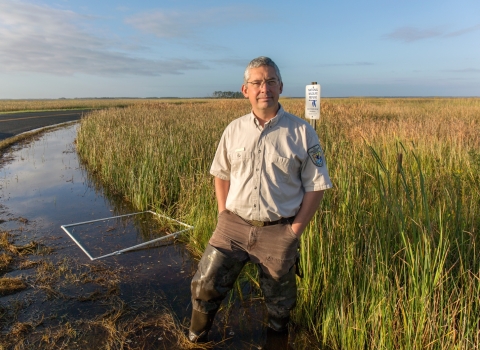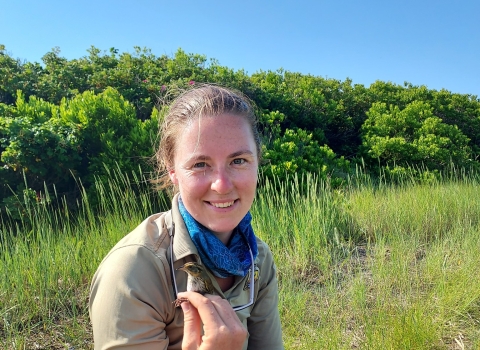Whether it’s their salty-sweet brine when served on a half shell or the stunning treasures they yield, oysters are synonymous with luxury and wealth. However, their true value is just now being uncovered.
A changing climate causing coastal concerns
Across the country, national wildlife refuges and private and public beaches alike are scrambling to secure their shores as rising tides and damaging storms threaten to wash them away. Climate change is warming our seas. This not only melts glaciers but expands the volume of salt water, raising our oceans to dangerous levels. With coastal flooding and severe storms on the rise, our sands are being bombarded by waves, resulting in extensive erosion.
According to the National Oceanic and Atmospheric Administration, from 2006 to 2015, the global rate of sea-level rise was more than double the average rate for the 1900s. High-tide flooding is now three to nine times more frequent than it was 50 years ago, depending on location.
That flooding is expensive and dangerous. The rising waters threaten infrastructure including oil and gas wells, power plants, subways, bridges, businesses and homes. Nearly 30 percent of the United States population lives in coastal areas that may be vulnerable to sea level rise. Even without flooding, rising tides have the potential to erode the beaches that support entire coastal communities with valuable tourism and commercial fishing.
These beaches are not only essential for local communities, they serve as nesting and breeding habitat for seaside species. For example, horseshoe crabs visit the beaches of the Delaware Bay for this species’ largest spawning event in the world. In turn, their eggs sustain nesting sea turtles and shorebirds who will rely on these nutrients for their long migrations. This hot spot for marine wildlife, is seeing the effects of rising tides. The near-shore natural reefs that once served as breakwaters have disappeared from the bay, leaving the shoreline exposed to strong wave action.
When Hurricane Sandy tore through coastal New Jersey and Delaware, communities witnessed first-hand the vulnerability of unprotected shores. Beaches all along the bay were washed into the sea, leaving habitat fragmented and homes and infrastructure destroyed.
As scientists and landowners alike looked to replace the reefs that once sheltered their shores, they faced a new challenge. How do we develop a solution to keep up with the changing tide?
Enter the oysters.
Unlike concrete seawalls and rip rap (a layer of human-placed rocks and rubble), oyster reefs are living, growing barriers. Held together by netting or castle-like structures, these barriers are filled with empty welk, clam, and oyster shells, creating exceptional habitat for spawning native oysters. The oysters cling to the shells and to one another, slowly building up a natural reef barrier. This solid structure structure
Something temporarily or permanently constructed, built, or placed; and constructed of natural or manufactured parts including, but not limited to, a building, shed, cabin, porch, bridge, walkway, stair steps, sign, landing, platform, dock, rack, fence, telecommunication device, antennae, fish cleaning table, satellite dish/mount, or well head.
Learn more about structure continues to grow and expand as it accumulates more and more oysters, thus becoming a naturally sustainable solution.
The U.S. Fish and Wildlife Service used funding for Hurricane Sandy restoration to implement this innovative idea. In 2015, we granted The Nature Conservancy $880,000 to work alongside The Partnership for the Delaware Estuary, Rutgers University, and other organizations to construct nearly 3,000 feet of oyster reef at Gandy’s Beach in New Jersey.
The team was thrilled when oysters quickly inhabited the newly constructed barriers. The barriers consistently accrued natural oysters and achieved over 70% survival rates.
Despite its success as habitat, the project faced a new problem
High stakes and an even higher tide
“The oyster castles were designed using data collected 12 years ago,” said U.S. Fish and Wildlife Service Biologist Danielle N. McCulloch.
Those dozen years saw sea level rise more quickly than expected. At lower tides the reefs reduced erosion and stabilized sediment. However, tides were higher than anticipated, and at their peak, waves simply rolled over the barriers, resulting in continued beach erosion.
For better or worse, they were not alone in this issue.
The Service’s Delaware River Basin Restoration Program administers the Delaware Watershed Conservation Fund in partnership with the National Fish and Wildlife Foundation. In 2019, the program granted the American Littoral Society nearly $500,000 to complete a restoration project at Cooks Beach in Cape May County, New Jersey.
As part of the project, the Society constructed a barrier reef using five by ten-foot blocks of shell bags. To replicate natural reefs that once occupied the bay, two parallel barriers were developed, each with strategic openings to allow horseshoe crab to pass through.
As part of the project, the Society constructed a barrier reef using five by ten-foot blocks of shell bags. To replicate natural reefs that once occupied the bay, two parallel barriers were developed, each with strategic openings to allow horseshoe crab to pass through.
At two to three feet tall, the barriers reduced erosion during low and mid tide but unfortunately, given the rapid increase in sea level, were ineffective at high tide.
A pearl of potential
Where some may have been disappointed, these teams were hopeful.
"Those Sandy projects were designed for past conditions and may not be controlling all the shoreline erosion today, but the lessons learned are the foundation to creating bigger and better projects for the future.” said McCulloch.
Already, the American Littoral Society is piloting new projects using the information gathered from these oyster-reef barriers.
“We have determined from these initial projects that we may need taller hybridized rock structures to break up the wave energy,” said Project Lead Shane Godshall. “In order to make a shell bag reef taller, it needs to get wider requiring more shell bags than would be feasible. Without a solid support, the taller shell bag structures wouldn’t be able to withstand increased wave action and would be knocked down.”
With this new information in mind, the Society is working to construct hybrid rock and oyster shell structures that could be the future of coastal conservation.
So, what happens to those oyster barriers already built?
While they may not have completely resolved the erosion issue, these reefs have been restoring the coast in other ways. Oysters are wonderful water filters. One oyster can filter between 30 and 40 gallons of water each day. This improves water quality for all the coastal species that call Delaware Bay home.
According to Rutgers Haskin Shellfish Laboratory, between 2017 and 2019, twenty-seven fish species were collected nearby the barriers at Gandy’s Beach including black drum, striped bass, northern kingfish, weakfish, and blue crab. Much of the fish collected were juveniles indicating that the newly constructed reefs are serving as a nursery. Both project leaders have seen increased fishing around the oyster barriers and local anglers have expressed their delight and gratitude at the influx of game fish.
These barriers have attracted not only fish but people as well. Volunteers assisted with the construction and placement of the oyster reefs at both Gandy’s Beach and Cooks Beach as well as several other restoration projects along the bay. After witnessing the devastation of sea-level rise and Hurricane Sandy, the locals were eager to get involved.
“These communities saw this as an opportunity to participate in projects that benefit their neighborhoods,” said Godshall. “And we’ve seen our relationship with those communities improve as a result. These volunteers have become stewards for the bay and the projects they helped build.”
“It’s like a win, win, win,” said McCulloch. “We are protecting people’s homes; we are helping the ecosystem; and we are combating sea-level rise.”
Despite the challenges, oysters continue to improve habitat. More importantly they are inspiring both communities and conservation organizations to reach higher and push farther in order to protect our shores for today and tomorrow. That is priceless.

